John B. Sanfilippo & Son Bundle
How Did a Small Pecan Shelling Operation Become a Billion-Dollar Nut Empire?
Journey back in time to uncover the captivating John B. Sanfilippo & Son SWOT Analysis, a story of entrepreneurial spirit and relentless innovation. From its humble beginnings in 1922 Chicago, this nut company has transformed the landscape of the nut and dried fruit industry. Discover the pivotal moments that shaped JB Sanfilippo & Son into a market leader, processing and distributing products under brands like Fisher Nuts.
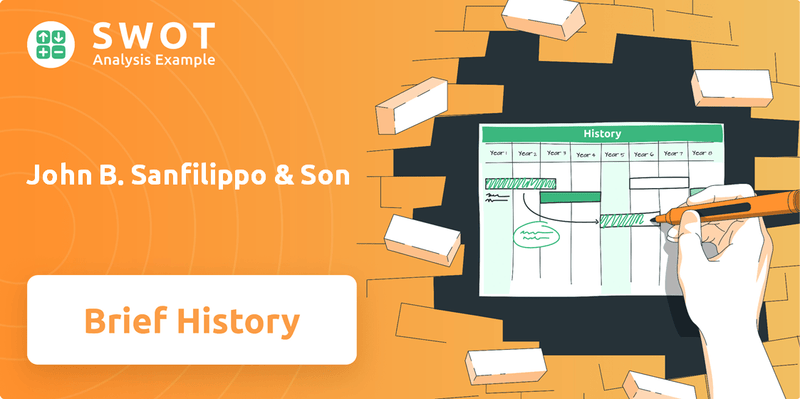
This deep dive into the Sanfilippo Company History will explore the evolution of John B. Sanfilippo & Son, from its origins as a family business to its current status as a major player in the global snack market. Learn about the company's strategic adaptations, technological advancements in nut processing, and the key drivers behind its impressive financial growth, including exceeding $1 billion in annual net sales in fiscal year 2024. Uncover the brief history of Fisher Nuts and how they became a household name.
What is the John B. Sanfilippo & Son Founding Story?
The story of John B. Sanfilippo & Son, Inc. began in 1922, a testament to the entrepreneurial spirit of Sicilian immigrants Gaspare Sanfilippo and his son, John B. Sanfilippo, in Chicago, Illinois. Their journey started with a deep-rooted connection to the pecan industry, a path they knew well from their earlier days as pecan shellers.
Before establishing their own company, Gaspare and John B. were involved in shelling pecans, earning approximately $6 daily for shelling around 40 pounds of pecans each. This manual labor was a common practice at the time, with Chicago serving as a central hub for pecan shelling. The city had as many as seventy such businesses during the era of the Great Depression.
The initial business model was a small pecan shelling operation, which began with cracking pecans around the kitchen table. By 1922, John B. rented a small storefront on Larrabee Street in Chicago, supplying shelled pecans to various distributors, nut shops, confectioneries, and candymakers. Later, Gaspare and John B. expanded their operations by opening a small factory on Division Street to further process pecans. The business evolved, and in the early 1950s, John B.'s son, Jasper, joined the family business. In 1959, the storefront business was officially renamed John B. Sanfilippo & Son. The company's operations later moved to a new building on Montrose Avenue in northwest Chicago, marking an early step in their expansion and diversification.
The Sanfilippo family's venture began with a focus on pecan shelling, a common practice in Chicago during the early 20th century. The company's growth involved moving from a kitchen table operation to a storefront and then to a factory.
- Gaspare and John B. Sanfilippo started as pecan shellers.
- The company was officially named John B. Sanfilippo & Son in 1959.
- The company's early operations were based in Chicago.
- The business expanded from shelling to processing and distribution.
The company's early success laid the groundwork for its future. To learn more about how the company has grown over the years, check out the Growth Strategy of John B. Sanfilippo & Son.
John B. Sanfilippo & Son SWOT Analysis
- Complete SWOT Breakdown
- Fully Customizable
- Editable in Excel & Word
- Professional Formatting
- Investor-Ready Format
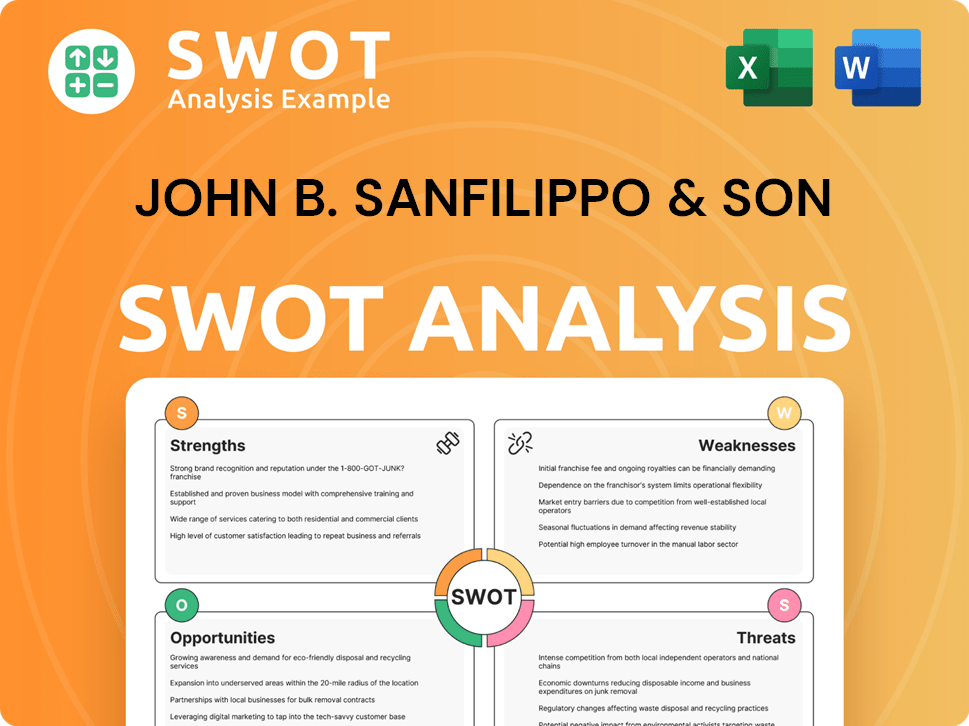
What Drove the Early Growth of John B. Sanfilippo & Son?
The early growth and expansion of John B. Sanfilippo & Son marked a significant transformation from a local pecan shelling operation to a diversified nut processing and distribution enterprise. This evolution included strategic moves that broadened its product offerings and market reach. Key decisions, such as facility expansions and the adoption of new distribution channels, were critical to its development. The company's journey reflects a commitment to growth and adaptation within the competitive nut industry.
In 1959, the company, now officially named John B. Sanfilippo & Son, moved to a new facility in Chicago, which was a step towards diversification. This period saw the expansion of the product line beyond pecans. By 1963, the company's sales reached $300,000, indicating early success in its growth strategy.
Following the passing of John B. Sanfilippo, Jasper Sanfilippo took over and expanded the company's distribution network, including deals with almond, walnut, and peanut shellers. The company also established a broker network to sell products to industrial clients, such as bakeries and confectioners. Simultaneously, Sanfilippo began retail sales under the 'Prairie State' brand.
A significant opportunity arose in 1974 with the bankruptcy of H.H. Evon Co., enabling Sanfilippo to increase its market presence. In 1980, the company built a highly automated pecan processing facility in Elk Grove Village, Illinois, which helped control costs and improve profit margins. This facility, spanning 135,000 square feet, cost $9 million.
By 1991, John B. Sanfilippo & Son's sales had grown to over $161 million, demonstrating substantial growth. Production volumes reached 103 million pounds of peanuts and 37 million pounds of walnuts, pecans, and other nut products, reflecting the company's increased operational scale. The company's focus on efficiency and market expansion contributed to its financial success.
John B. Sanfilippo & Son PESTLE Analysis
- Covers All 6 PESTLE Categories
- No Research Needed – Save Hours of Work
- Built by Experts, Trusted by Consultants
- Instant Download, Ready to Use
- 100% Editable, Fully Customizable
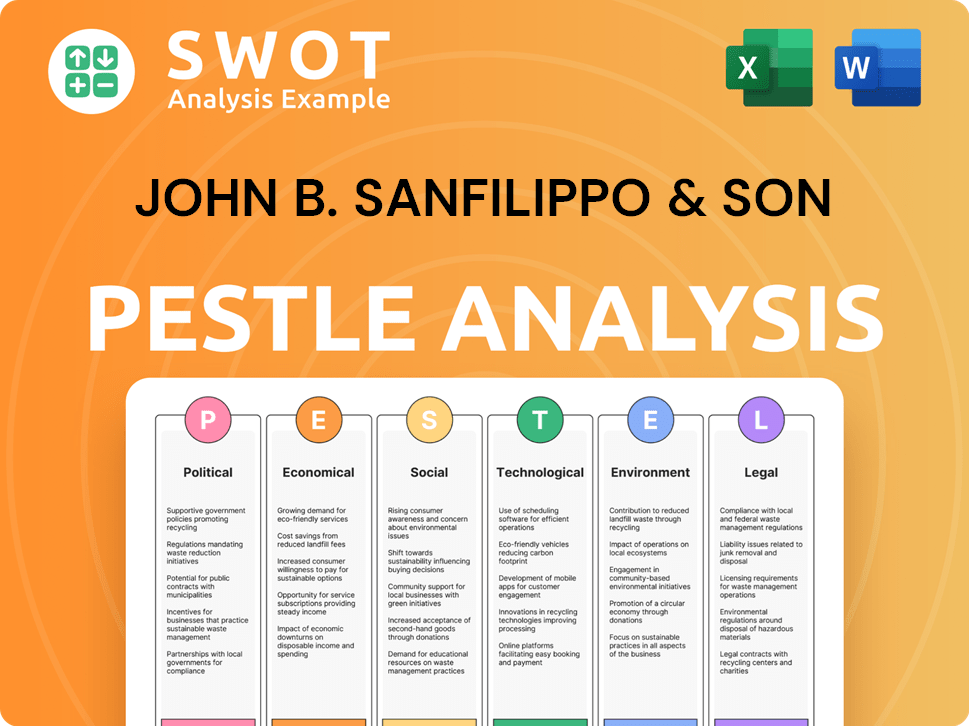
What are the key Milestones in John B. Sanfilippo & Son history?
The John B. Sanfilippo & Son company history is marked by significant milestones in the nut processing industry, expanding its market presence and product offerings. From its early days to the present, the company has achieved notable advancements in its business operations.
| Year | Milestone |
|---|---|
| 1995 | Acquisition of Fisher Nuts from Proctor & Gamble, marking entry into the national brand product line and expanding the product range. |
| 1927 | Fisher Nuts established, later becoming JBSS's first national brand, which was expanded to include baking nuts. |
| Ongoing | Diversification of brand portfolio to include Orchard Valley Harvest, Squirrel Brand, Southern Style Nuts, and Just the Cheese, alongside private brand offerings. |
JB Sanfilippo & Son has consistently focused on innovation in its operations. The company has invested in R&D to develop differentiated products and has partnered with Syndigo to enhance its digital content management, leading to a 62% growth in e-commerce sales.
In the late 1930s, the family transformed their shelling processes from manual to automated, a hallmark of their manufacturing innovation.
The construction of a state-of-the-art pecan processing facility in Elk Grove Village in 1980, designed by Jasper Sanfilippo, incorporated advanced automation.
Another significant innovation was the development of a peanut plant capable of performing the entire production process, the first and only in the world at the time.
In recent times, JBSS has invested in R&D to develop differentiated products.
Partnering with Syndigo to enhance its digital content management, leading to a 62% growth in e-commerce sales.
Advanced automation allowed the company to control the full range of manufacturing processes and improve cost efficiency.
Despite these achievements, the Sanfilippo Company History has faced several challenges. The company has contended with competitive pricing pressures and strategic pricing decisions that have impacted average selling prices and gross profit margins. The company's Q3 fiscal year 2025 performance was impacted by a challenging macroeconomic and consumer environment, leading to a 7.9% decrease in sales volume, although gross profit and diluted EPS increased due to cost control and pricing strategies.
Competitive pricing pressures have impacted average selling prices and gross profit margins. For instance, in Q2 fiscal year 2025, the gross profit margin decreased to 17.4% from 19.9% in the prior year.
The weighted average cost per pound of raw nut and dried fruit input stock increased by 33.7% year-over-year in Q2 fiscal year 2025, primarily due to higher commodity acquisition costs for most major tree nuts.
Supply chain constraints and fluctuations in the market price of nuts also pose ongoing challenges.
To overcome these challenges, JBSS plans to implement price increases and invest approximately $90 million by the end of fiscal year 2026 to expand domestic production capabilities and improve infrastructure.
These investments aim to increase efficiency and reduce reliance on imported raw materials, which face tariffs.
The company's Q3 fiscal year 2025 performance was impacted by a challenging macroeconomic and consumer environment.
For a deeper dive into the John B. Sanfilippo & Son market, consider exploring the Target Market of John B. Sanfilippo & Son.
John B. Sanfilippo & Son Business Model Canvas
- Complete 9-Block Business Model Canvas
- Effortlessly Communicate Your Business Strategy
- Investor-Ready BMC Format
- 100% Editable and Customizable
- Clear and Structured Layout
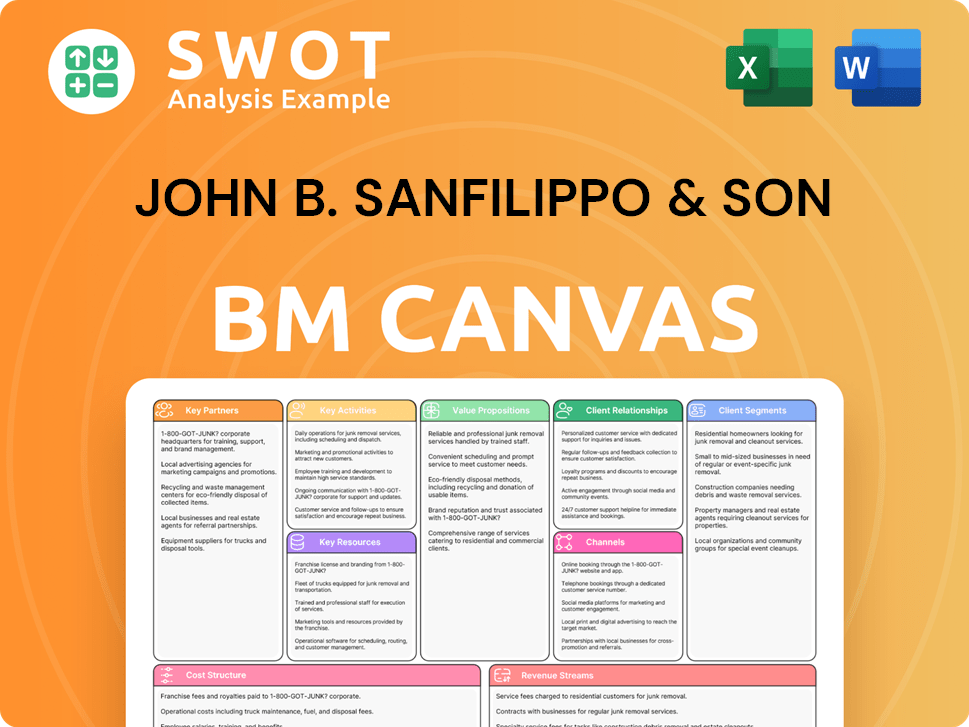
What is the Timeline of Key Events for John B. Sanfilippo & Son?
The Sanfilippo Company History is a story of growth and strategic adaptation within the nut processing industry. From its humble beginnings in 1922 as a pecan shelling company, John B. Sanfilippo & Son, has evolved into a major player, marked by key acquisitions like Fisher Nuts, and significant expansions in processing capabilities. The company's financial milestones, including exceeding $1 billion in net sales in fiscal year 2024, underscore its sustained success and strategic vision. The JB Sanfilippo & Son has consistently adapted to market trends, ensuring its place in the competitive landscape. The company's commitment to innovation and expansion positions it for continued success in the future.
| Year | Key Event |
|---|---|
| 1922 | Gaspare Sanfilippo and his son John B. found a pecan shelling company in Chicago, Illinois. |
| 1929 | Gaspare and John hand-paint a sign on their first 2,500 square foot facility on Division Street. |
| 1959 | The company is formally renamed John B. Sanfilippo & Son, as John's son Jasper joins the business, and operations move to Montrose Avenue in Chicago. |
| 1963 | Company sales reach $300,000; Jasper Sanfilippo takes leadership after John B.'s passing, initiating diversification into other nuts and retail sales. |
| 1974 | Acquisition of H.H. Evon Co. assets expands distribution throughout the Midwest. |
| 1979 | John B. Sanfilippo & Son, Inc. is formed as a Delaware corporation, succeeding the Illinois corporation incorporated in 1959. |
| 1980 | A modern, automated pecan processing facility is constructed in Elk Grove Village, Illinois, becoming the corporate headquarters. |
| 1986-1987 | A shelling, blanching, and processing facility is built in Bainbridge, Georgia, making JBSS a vertically integrated supplier of runner type peanuts. |
| 1991 | Sales top $161 million, with significant production volumes in peanuts and other nuts. |
| 1995 | Acquisition of Fisher Nuts from Proctor & Gamble, marking JBSS's entry into national branded products. |
| 2008 | A new state-of-the-art processing facility is opened in Elgin, Illinois. |
| 2022 | John B. Sanfilippo & Son celebrates its 100-year anniversary. |
| 2023 (September 29) | Acquisition of the TreeHouse Foods snack bar business (Lakeville Acquisition), significantly diversifying product offerings. |
| Fiscal Year 2024 (ended June 27, 2024) | Exceeds $1 billion in annual net sales for the first time, reaching $1.07 billion. |
| Fiscal Year 2025 (Q2 ended December 26, 2024) | Reports largest quarterly sales volume and highest net sales in company history at $301.1 million. |
| Fiscal Year 2025 (Q3 ended March 27, 2025) | Net sales of $260.9 million, with diluted EPS increasing 50% to $1.72 per share. |
The company is focused on accelerating volume growth, expanding its private brand portfolio, and rebuilding its nuts and trail mix business. Consolidation of distribution operations in Huntley, Illinois, will free up space for expanded production. The company is investing approximately $90 million in equipment to expand domestic production by the end of fiscal year 2026.
John B. Sanfilippo & Son aims to become a $2 billion business. The company is focused on strategic initiatives and cost control. Despite potential challenges from the macroeconomic environment, the company is committed to adapting to evolving customer needs. The company's financial performance is driven by a focus on innovation and strategic acquisitions.
The global dried fruits and nuts market is expected to continue growing. This growth is driven by increasing health consciousness and demand for natural and organic products. This provides a favorable environment for the future growth of John B. Sanfilippo & Son. The company is well-positioned to capitalize on these trends.
The company plans to complete the consolidation of its Elgin and Lakeville distribution operations into a new 400,000-square-foot warehouse in Huntley, Illinois. This will free up 250,000 square feet for expanded production of bars and nut and trail mix packaging. This strategic move aims to enhance efficiency and reduce reliance on imported raw materials.
John B. Sanfilippo & Son Porter's Five Forces Analysis
- Covers All 5 Competitive Forces in Detail
- Structured for Consultants, Students, and Founders
- 100% Editable in Microsoft Word & Excel
- Instant Digital Download – Use Immediately
- Compatible with Mac & PC – Fully Unlocked
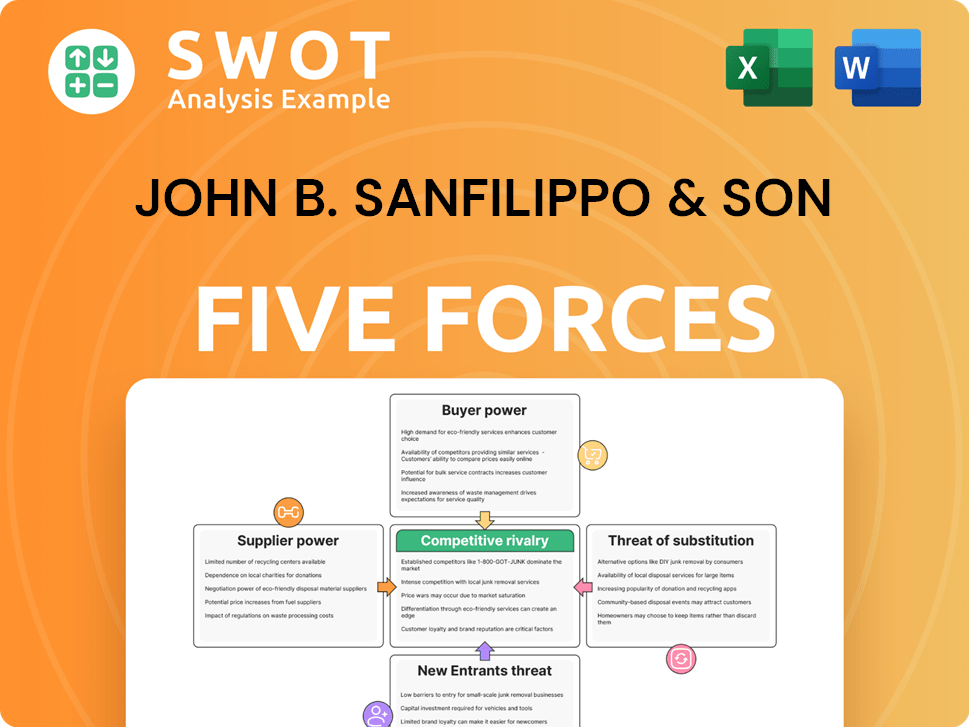
Related Blogs
- What is Competitive Landscape of John B. Sanfilippo & Son Company?
- What is Growth Strategy and Future Prospects of John B. Sanfilippo & Son Company?
- How Does John B. Sanfilippo & Son Company Work?
- What is Sales and Marketing Strategy of John B. Sanfilippo & Son Company?
- What is Brief History of John B. Sanfilippo & Son Company?
- Who Owns John B. Sanfilippo & Son Company?
- What is Customer Demographics and Target Market of John B. Sanfilippo & Son Company?
Disclaimer
All information, articles, and product details provided on this website are for general informational and educational purposes only. We do not claim any ownership over, nor do we intend to infringe upon, any trademarks, copyrights, logos, brand names, or other intellectual property mentioned or depicted on this site. Such intellectual property remains the property of its respective owners, and any references here are made solely for identification or informational purposes, without implying any affiliation, endorsement, or partnership.
We make no representations or warranties, express or implied, regarding the accuracy, completeness, or suitability of any content or products presented. Nothing on this website should be construed as legal, tax, investment, financial, medical, or other professional advice. In addition, no part of this site—including articles or product references—constitutes a solicitation, recommendation, endorsement, advertisement, or offer to buy or sell any securities, franchises, or other financial instruments, particularly in jurisdictions where such activity would be unlawful.
All content is of a general nature and may not address the specific circumstances of any individual or entity. It is not a substitute for professional advice or services. Any actions you take based on the information provided here are strictly at your own risk. You accept full responsibility for any decisions or outcomes arising from your use of this website and agree to release us from any liability in connection with your use of, or reliance upon, the content or products found herein.